R. T. Glenn-Borade1,2, B. Adams3, R. Schaeffer4, C. SimsKayotuk5, G. Omnik6, J. M. Leavitt3, and D. D. W. Hauser1,2
1International Arctic Research Center, University of Alaska Fairbanks, Fairbanks, AK, USA
2Alaska Arctic Observatory and Knowledge Hub, Fairbanks, AK, USA
3Alaska Arctic Observatory and Knowledge Hub, Utqiaġvik, AK, USA
4Alaska Arctic Observatory and Knowledge Hub, Kotzebue, AK, USA
5Alaska Arctic Observatory and Knowledge Hub, Kaktovik, AK, USA
6Alaska Arctic Observatory and Knowledge Hub, Point Hope, AK, USA
Headlines
- The Alaska Arctic Observatory and Knowledge Hub (AAOKH) works with a network of coastal Indigenous observers to document long-term and holistic observations of environmental change and impacts in northern Alaska.
- Recently, Indigenous observers have noted sea ice loss, warmer air and ocean temperatures, changing wind patterns, and increased intensity and frequency of coastal storms that contribute to flooding and erosion.
- Indigenous observers also document local-scale impacts of environmental changes to community and cultural infrastructure, traditional harvests and activities, and travel safety across the land and sea.
- Applying and centering Indigenous perspectives and observations of Arctic change in decision-making can lead to more inclusive, equitable, and community-led responses.
Introduction
“What is a key environmental change in your community that you want people to know about?” “The sea ice and permafrost are melting too fast.“
– Joe Mello Leavitt [Iñupiat], Utqiaġvik (AAOKH 2023).
Numerous lines of evidence indicate how climate change is unfolding in the Arctic (see essay Executive Summary). Understanding and responding to these changes, many of which impact coastal Indigenous communities, can be strengthened by the inclusion of community-based observations. Community-based observations provide a local perspective not available through conventional scientific methods alone and can fill existing spatial or temporal knowledge gaps (Danielsen et al. 2020; Eicken et al. 2021).
The Alaska Arctic Observatory and Knowledge Hub (AAOKH) is a collaboration between university scientists and a network of Iñupiaq observers in northern Alaska coastal communities (Fig. 1). AAOKH (pronounced “A-OK”) provides long-term documentation of weather, ocean, sea ice, and landscape conditions and context to wildlife, harvesting, and cultural and community activities (e.g., Fig. 2) by creating space for Indigenous Knowledge holders to share their expertise and observations of environmental change. The primary objectives of AAOKH, determined by the observers, are to sustain Arctic Indigenous observing, support Indigenous scholarship, and apply observations to inform decision-making in response to environmental change (Hauser et al. 2023). Here, we describe themes in environmental changes observed across the AAOKH network. We also describe our overall efforts to increase knowledge exchange, leveraging our experiences combining scientific measurements with observations to create relevant data products that can directly support community priorities (Hauser et al. 2023).
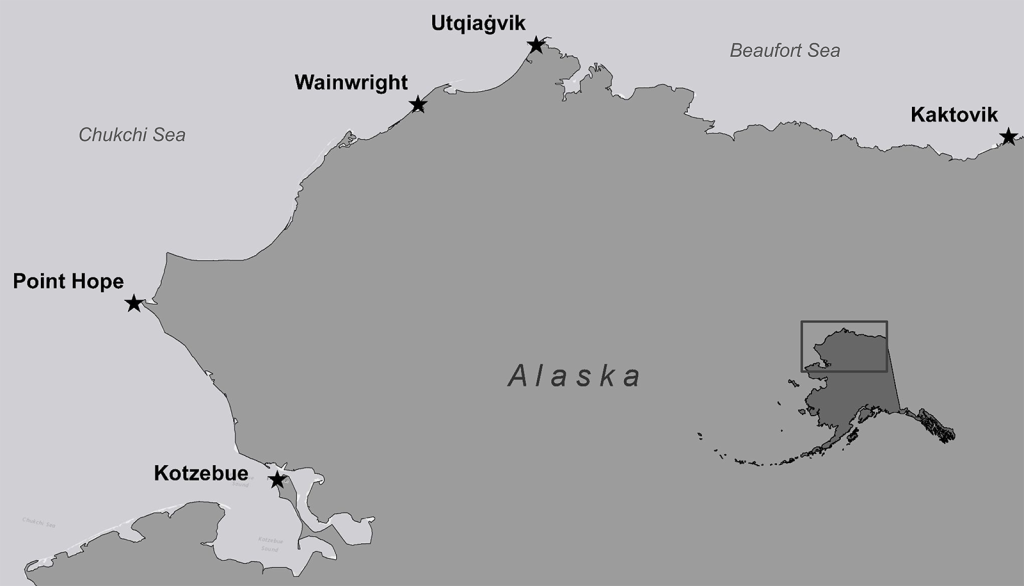
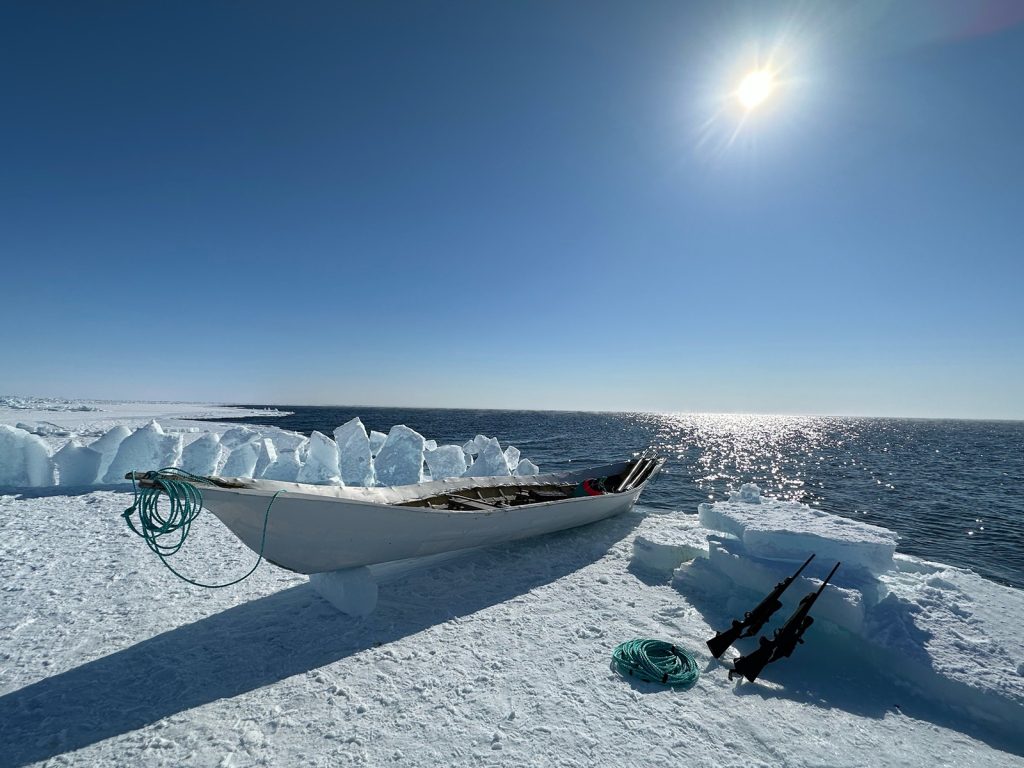

Observations are the foundation of the AAOKH Network
“Global warming is happening. It is affecting different villages in different ways. I collect observations…this is an important tool for the future”… “We can look back on these observations in years to come…[and] compare if there are any dramatic changes.“
– Guy Norman Omnik [Iñupiat], Point Hope, shared December 2020 (quoted in Hauser et al. 2023)
Arctic coastal communities have long recognized that sea ice conditions are changing. The ocean is freezing later in fall and melting earlier in spring, shorefast sea ice is less stable, and thick multiyear sea ice is harder to find (see essay Sea Ice). Overall, conditions are considered less predictable (Hauser et al. 2021). Several themes of physical environmental changes have been reported by AAOKH observers, including warmer air and ocean temperatures, shifts in prevailing wind direction and intensity, and increasing frequency of coastal storms, all of which affect community subsistence calendars and infrastructure (Glenn et al. 2022).
Fall storms were a key observing theme among AAOKH communities in 2022-23. Lack of sea ice makes coastal communities more vulnerable to storm impacts, as noted by Bobby Schaeffer in Kotzebue and Billy Adams in Utqiaġvik:
“We had three strong storms. The July 18 storm had the strongest winds. Southwest winds to 50 mph brought in a storm surge that set the record… Wind, huge surf and a lot of rain. The second storm hit us on July 28 and Merbok on September 14 [to 18]… I think we lost more earth to the ocean than ever before.“
– Bobby Schaeffer [Iñupiat], Kotzebue, September 2022 (AAOKH 2023, see Fig. 3).
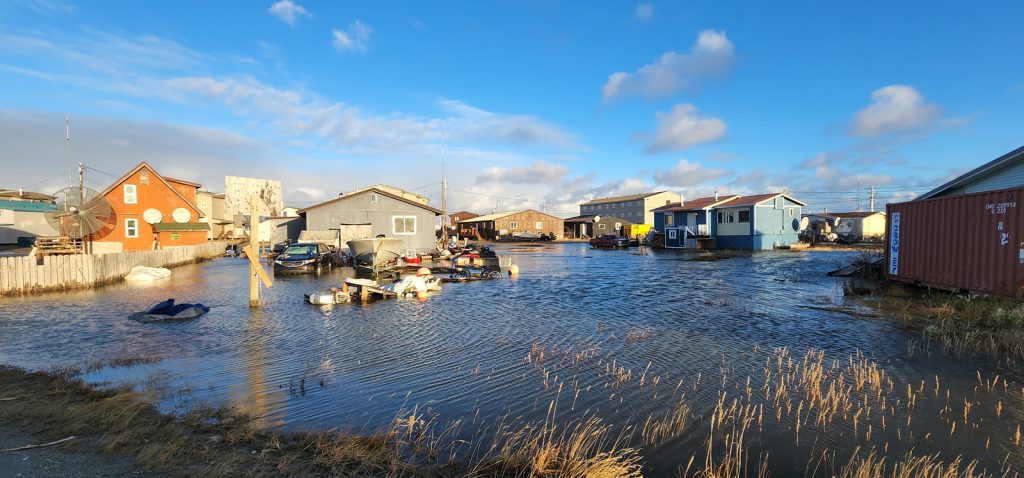

“The storm like this reminds us the true power of nature! Erosion, west winds, waves and high water levels were key factors in this storm. The winds were not as high as we thought they were predicted to be but all the other factors were in line to cause significant damage. We hope to be much more prepared as we should take notes and learn from this.“
– Billy Adams [Iñupiat], Utqiaġvik, 10 October 2022 (AAOKH 2023).
Storms, and associated flooding or erosion, impact roads and buildings and also cultural infrastructure, such as community ice cellars, which are critical to Indigenous food security (Fig. 4).
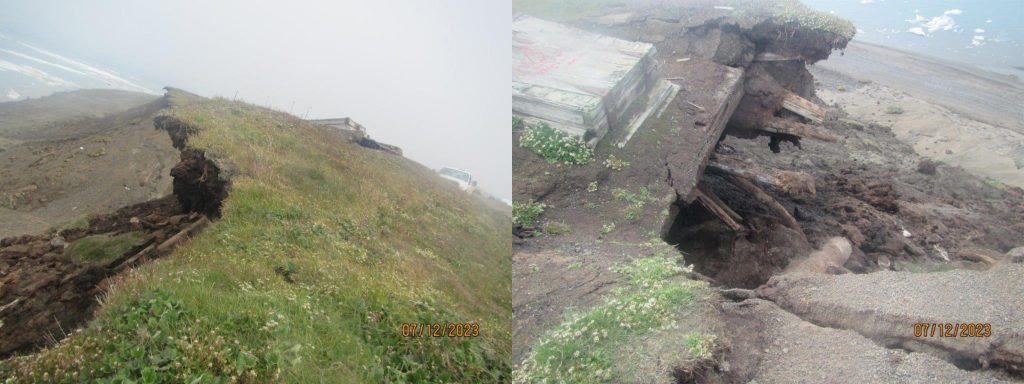

Weather and temperature changes in turn affect the animals and their ecosystem, as noted by Carla SimsKayotuk and Billy Adams. This includes temporal shifts in location and abundance of various subsistence resources, including fish, waterfowl, caribou, and marine mammals (Glenn et al. 2022).
“Wind, fog, rain and sun today. Still a bit too rough to go whaling. Bears are keeping the community busy. Feels like 28. Winds are down to 10 NE.” “Very strong winds out of the east. Gusting to 45, making it feel like 22. Lagoon and ocean are both very rough and whitecaps. High count of polar bears is 48 around our area.“
– Carla SimsKayotuk [Iñupiat], Kaktovik, 14-17 September 2022 (Fig. 5).
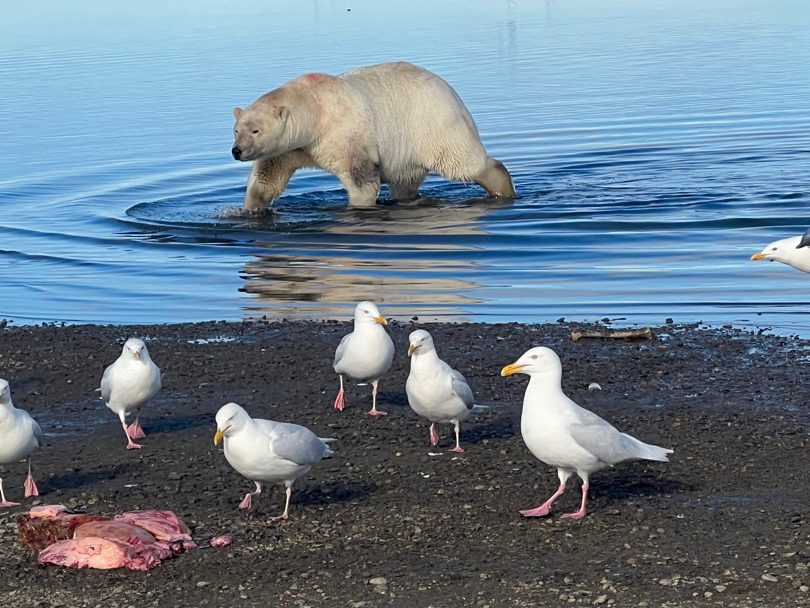

“The westerly winds have been consistent since late January, this has brought in the pack ice up against the shorefast ice. The east side of Pt. Barrow has been the area of open water making it a productive area for animals.“
– Billy Adams [Iñupiat], Utqiaġvik, 11 March 2023 (Fig. 6)
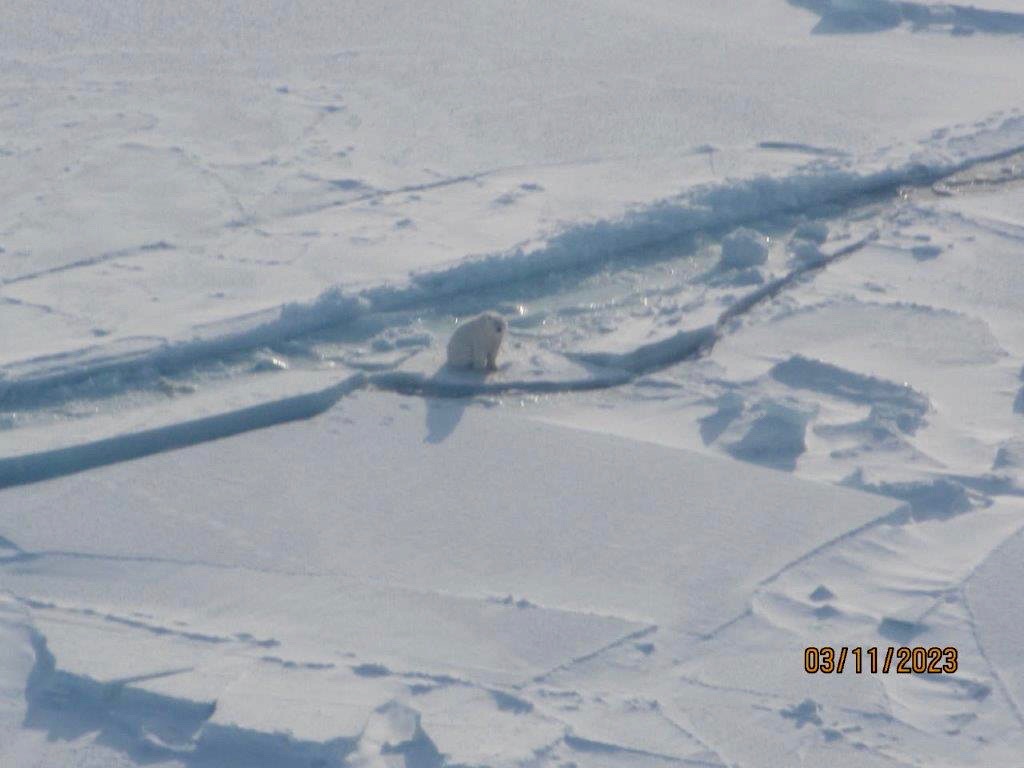

Observations can inform decision-making
“I think it is really important that our observations are being used by tribes for planning purposes. What about documenting storms or supporting food security? We are documenting these observations for the first time. How can tribes use our observations for planning?“
– Bobby Schaeffer [Iñupiat], Kotzebue, shared 30 November 2022
An increasing emphasis of AAOKH is to build connections across regional, national, and international scales, with entities such as wildlife co-management organizations, tribal governments, and federal agencies that could use observations to support decision-making. Through long-term community-based observing, local knowledge and observations can be applied to decision-making regarding Indigenous peoples, communities, and the land and resources on which they depend and thrive, leading to more sustainable and effective approaches to resource management and climate change adaptation (e.g., Carothers et al. 2021). For example, regular sea ice and weather observations help improve remotely-sensed data interpretation, which can lead to better forecasts and climate models (e.g., Fox et al. 2020; Simonee et al. 2021). Observer reports also inform hunters or travelers going out on the ocean or sea ice (e.g., Druckenmiller et al. 2013). Similarly, observations of fish or wildlife presence, abundance, location, body condition, and other information can be used to elevate the use of Indigenous data in wildlife co-management decision-making about how and when Indigenous people can legally harvest their traditional foods (e.g., Breton-Honeyman et al. 2021).
Collaboration to achieve a shared vision moving forward
“I think the most important thing is that we’ve fostered a level of trust among our community members and the scientific community… So if we could keep it going, if we have the funding to do it, and keep the trust of our communities with them. Otherwise we’ll start over again and they’ll have to gain their trust again, and that could be another hurdle, and that could take away from valuable time that we could be doing towards research.“
– Noah Naylor [Iñupiat], Kotzebue, AAOKH Steering Group member (quoted in Hauser et al. 2023)
Complementing Indigenous Knowledge and observations with scientific research enhances our understanding of Arctic environmental change, promotes holistic approaches to observing, and helps to identify strategies for adaptation that are rooted in local priorities. AAOKH’s network and organizational structure intentionally creates space for knowledge exchange and feedback on program activities and research products. This dialogue between university researchers and Indigenous Knowledge holders helps to establish shared understandings about Arctic environmental change and particularly impacts to Indigenous communities. These shared understandings are the foundation on which AAOKH will move forward, sustaining long-term observations while also addressing priorities and research questions advanced by community and regional partners.
Despite well-documented literature on Arctic environmental change, efforts to understand and respond to these changes are often led by outside researchers and do not address the perspectives and priorities of local Indigenous Peoples (Ellam Yua et al. 2022; Knapp and Trainor 2015). Lack of engagement to understand and respond to local priorities perpetuates further colonialism and inequity in Arctic research, disregarding pre-existing knowledge systems and oral histories that can inform and lead scientific research (Inuit Circumpolar Council 2022). Research done in Indigenous communities, without inclusion of and credit to the people living there, further disenfranchises Indigenous people, their knowledge systems, and their histories on the land. We recognize the importance of collaborative research approaches that honor and uplift Indigenous Knowledge holders and their connections to the land and sea. By amplifying Indigenous Knowledge and observations, AAOKH aims to challenge the power imbalances inherent in conventional scientific practices and contribute to the transformation of Arctic observing protocols to better serve Indigenous Peoples and communities.
Methods and data
AAOKH’s five current observers are residents of four predominantly Iñupiaq communities along northern coastal Alaska (Kotzebue, Point Hope, Utqiaġvik, and Kaktovik). Observers lead traditional Iñupiaq ways of life based on the land and sea and contribute regular observations that are significant to the observers, as described in Hauser et al. (2023). Over 10,000 observations, dating back to 2006, are archived and accessible in an online database, upon acceptance of data use agreements (Observers of Coastal Arctic Alaska 2022).
This essay is authored by Iñupiaq (R. G-B., R. S., B. A., C. S., G. O., J. M. L.) and non-Indigenous (D. D. W. H.) scholars to share research and activities from an interdisciplinary and cross-cultural team, each bringing unique knowledge, identities, experiences, and perspectives to the AAOKH project. We acknowledge that AAOKH communities have been stewarded as part of Iñupiaq homelands since time immemorial. Here, we identify cultural identities of our contributors to uplift and amplify the contributions of Indigenous researchers in the Arctic. We include direct quotations and text provided directly from community members and observers without edits to retain the intentions and perspectives shared by each individual. English is not always the first language of the contributor, and any edits or clarifications by the authors are included as [brackets].
References
Alaska Arctic Observatory and Knowledge Hub, 2023: AAOKH News. Issue 8, Winter 2023, https://arctic-aok.org/2023/02/21/hot-off-the-press-check-out-our-winter-2023-newsletter.
Breton-Honeyman, K., and Coauthors, 2021: Beluga whale stewardship and collaborative research practices among Indigenous peoples in the Arctic. Polar Res., 40(S1), https://doi.org/10.33265/polar.v40.5522.
Carothers, C., and Coauthors, 2021: Indigenous peoples and salmon stewardship: a critical relationship. Ecol. Soc., 26(1), 16, https://doi.org/10.5751/ES-11972-260116.
Danielsen, F., and Coauthors, 2020: Community-based monitoring in the Arctic. University Press of Colorado, Denver, CO, https://upcolorado.com/university-of-alaska-press/item/6022-community-based-monitoring-in-the-arctic.
Druckenmiller, M. L., H. Eicken, J. C. George, and L. Brower, 2013: Trails to the whale: reflections of change and choice on an Iñupiat icescape at Barrow, Alaska. Polar Geogr., 36, 5-29, https://doi.org/10.1080/1088937X.2012.724459.
Eicken, H., and Coauthors, 2021: Connecting top-down and bottom-up approaches in environmental observing. BioScience, 71, 467-483, https://doi.org/10.1093/biosci/biab018.
Ellam Yua, J. Raymond-Yakoubian, R. A. Daniel, and C. Behe, 2022: A framework for co-production of knowledge in the context of Arctic research. Ecol. Soc., 27(1), 34, https://doi.org/10.5751/ES-12960-270134.
Fox, S., E. Qillaq, I. Angutikjuak, D. J. Tigullaraq, R. Kautuk, H. Huntington, G. E. Liston, and K. Elder, 2020: Connecting understandings of weather and climate: steps towards co-production of knowledge and collaborative environmental management in Inuit Nunangat. Arct. Sci., 6, 267-278, https://doi.org/10.1139/as-2019-0010.
Glenn, R. G., D. D. W. Hauser, M. DeLue, B. Adams, J. Leavitt, G. Omnik, S. Patkotak, R. Schaeffer, and C. SimsKayotuk, 2022: Insights from Coastal Arctic Indigenous Observers, ArcGIS StoryMap available online, https://storymaps.arcgis.com/stories/30d30ab062ea4aadb39b3734dd7770ae.
Hauser, D. D. W., and Coauthors, 2021: Co-production of knowledge reveals loss of Indigenous hunting opportunities in the face of accelerating Arctic climate change. Environ. Res. Lett., 16, 095003, https://doi.org/10.1088/1748-9326/ac1a36.
Hauser, D. D. W., and Coauthors, 2023: Nunaaqqit Savaqatigivlugich—working with communities: evolving collaborations around an Alaska Arctic observatory and knowledge hub. Arct. Sci., 9, 635-656, https://doi.org/10.1139/as-2022-0044.
Inuit Circumpolar Council, 2022: Circumpolar Inuit Protocols for Equitable and Ethical Engagement, Technical report available online, https://www.inuitcircumpolar.com/project/circumpolar-inuit-protocols-for-equitable-and-ethical-engagement/.
Knapp, C. N., and S. F. Trainor, 2015: Alaskan stakeholder-defined research needs in the context of climate change. Polar Geogr., 38, 42-69, https://doi.org/10.1080/1088937X.2014.999844.
Observers of Coastal Arctic Alaska, 2022: Local Observations from the Seasonal Ice Zone Observing Network (SIZONet) and Alaska Arctic Observatory and Knowledge Hub (AAOKH), Version 2. Edited by the AAOKH Team, National Snow and Ice Data Center, Boulder, CO, https://doi.org/10.7265/jhws-b380.
Simonee, N., J. Alooloo, N. A. Carter, G. Ljubicic, and J. Dawson, 2021: Sila Qanuippa? (How’s the weather?): integrating Inuit Qaujimajatuqangit and environmental forecasting products to support travel safety around Pond Inlet, Nunavut, in a changing climate. Wea. Climate Soc., 13, 933-962, https://doi.org/10.1175/WCAS-D-20-0174.1.
November 13, 2023
